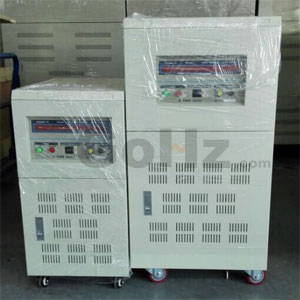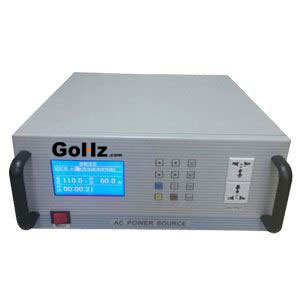Why we use 50Hz or 60Hz power system?
Tags: 50Hz vs 60Hz
50Hz was standardized and used first for land based systems but marine generators were standardized on 60Hz. I have never read 'actually why' there was a chosen difference but at 60Hz your alternator is a little smaller and lighter. Today, even in 50Hz territories, you will find ship-to-shore and shore-to-ship 50/60Hz converters in harbors and all ships are 60Hz even European ones. You can extend the same argument to aircraft and airport ground-power supplies - those are 400Hz (441Hz to be pedantic). This means that generators for aircraft auxiliary power loads are very small and light (useful for flying!). That also explains why early data-centers were 441Hz - IBM designed to aircraft technology, even in 60Hz land. I can only assume that the US followed ships rather than England!
These standards for the 50Hz/60Hz frequency have been established when they have tested on carbon lamps. The idea was that the lamp must not flick. Indeed it was the flicker that decided the standard of the frequency in Germany 50Hz and in USA 60Hz. It seems that the lamp in Germany was smaller (therefore, the flicking phenomena was slower due to the slower temperature dissipation inside the lamp). Therefore, they have chosen 50 Hz.
Now a day, we can not speak about any other frequency for power supplies, although they might be more economical and more secure, since all of our designs in power system network are based on these frequencies.
Actually many years ago 25 Hz was common mainly because early generation was dominated by hydroelectric plants. The turbines were slower and a lower frequency meant you didn't have to build so many poles into the machine. I don't believe flicker was an issue since that actual cycle of dim-bright is twice the electrical frequency as the filaments will heat up every half cycle.
When generation became more common in cities it was almost always steam turbine driven and tended more to higher frequencies. Higher frequencies don't require as much iron in transformers as the flux has less chance to build up. AC distribution on airplanes is sometimes 400Hz to keep the weight of transformers down.
Higher frequencies lower the ampacities of cables due to skin affect, and overall impedance is higher for the same line inductance when the frequency is higher. Of course one could debate the optimum Hz value for each situation, but it is more important to stick to the standard that has been agreed on.
These standards for the 50Hz/60Hz frequency have been established when they have tested on carbon lamps. The idea was that the lamp must not flick. Indeed it was the flicker that decided the standard of the frequency in Germany 50Hz and in USA 60Hz. It seems that the lamp in Germany was smaller (therefore, the flicking phenomena was slower due to the slower temperature dissipation inside the lamp). Therefore, they have chosen 50 Hz.
Now a day, we can not speak about any other frequency for power supplies, although they might be more economical and more secure, since all of our designs in power system network are based on these frequencies.
Actually many years ago 25 Hz was common mainly because early generation was dominated by hydroelectric plants. The turbines were slower and a lower frequency meant you didn't have to build so many poles into the machine. I don't believe flicker was an issue since that actual cycle of dim-bright is twice the electrical frequency as the filaments will heat up every half cycle.
When generation became more common in cities it was almost always steam turbine driven and tended more to higher frequencies. Higher frequencies don't require as much iron in transformers as the flux has less chance to build up. AC distribution on airplanes is sometimes 400Hz to keep the weight of transformers down.
Higher frequencies lower the ampacities of cables due to skin affect, and overall impedance is higher for the same line inductance when the frequency is higher. Of course one could debate the optimum Hz value for each situation, but it is more important to stick to the standard that has been agreed on.
Post a Comment:
You may also like:
50Hz 60Hz Frequency Converter Setting
Using GoHz frequency converter to
Or customize your own converters.
- Convert 220v 50Hz to 110v 60Hz,
- Convert 120v 60Hz to 230v 50Hz,
- Convert 110v 60Hz to 240v 50Hz,
- Convert 480v 60Hz to 380v 50Hz,
- Convert 400v 50Hz to 460v 60Hz,
- Convert 240v 60Hz to 380v 50Hz,
Or customize your own converters.
Featured Articles
460v 60Hz motor on 400v 50Hz power ...
 Often the European motors at 1hp size are universal for 50Hz or 60Hz power supply, as long as you have 400V x 50Hz and 460V x ...
Often the European motors at 1hp size are universal for 50Hz or 60Hz power supply, as long as you have 400V x 50Hz and 460V x ...
 Often the European motors at 1hp size are universal for 50Hz or 60Hz power supply, as long as you have 400V x 50Hz and 460V x ...
Often the European motors at 1hp size are universal for 50Hz or 60Hz power supply, as long as you have 400V x 50Hz and 460V x ...Convert 220v, 230v, 240v 50Hz to 110v, ...
 When you buy an 110v (120v) 60Hz appliance from USA, and run it on 220v (230v, 240v) 50Hz country (i.e. UK, Australia, ...
When you buy an 110v (120v) 60Hz appliance from USA, and run it on 220v (230v, 240v) 50Hz country (i.e. UK, Australia, ...
 When you buy an 110v (120v) 60Hz appliance from USA, and run it on 220v (230v, 240v) 50Hz country (i.e. UK, Australia, ...
When you buy an 110v (120v) 60Hz appliance from USA, and run it on 220v (230v, 240v) 50Hz country (i.e. UK, Australia, ...60Hz motor running on 50Hz power ...
 Electric motors, both single and three phase, are designed for running on a specified power frequency. But sometimes we may use a ...
Electric motors, both single and three phase, are designed for running on a specified power frequency. But sometimes we may use a ...
 Electric motors, both single and three phase, are designed for running on a specified power frequency. But sometimes we may use a ...
Electric motors, both single and three phase, are designed for running on a specified power frequency. But sometimes we may use a ...
The choice between 110/60Hz and 230/50Hz was more political/commercial than technical, paralleled later by the choice of TV standards which left countries following the USA, with pictures much inferior to those enjoyed in europe.
The heating effect of wound components in motors and transformers demanded large metal frames to dissipate the heat. The limiting factor being the melting point of the insulating varnish. The development of high temperature tolerant varning dramatically reduce the frame size for electric motors in the twentieth century